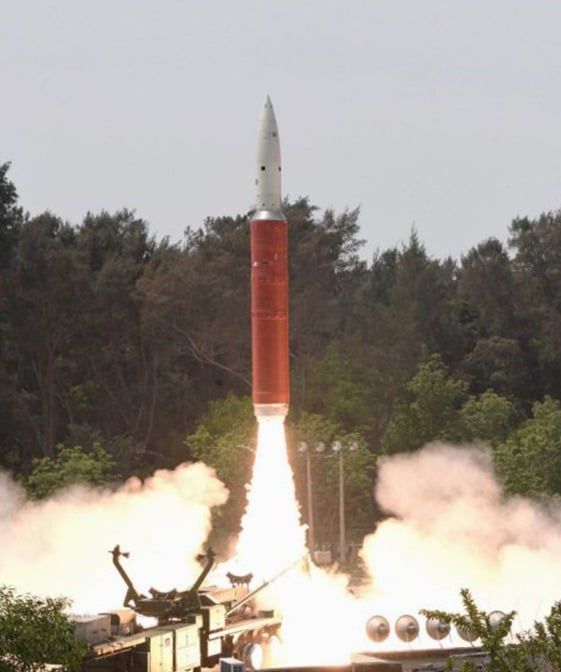An anti-satellite test ban is urgently needed
By Subrata Ghoshroy | April 19, 2019
 India’s government-run Defence Research and Development Organisation (DRDO) revealed new details about the successful March 27 test-firing of its first anti-satellite missile, which destroyed an Indian test satellite in low-Earth orbit. Image courtesy of DRDO/Press Information Bureau
India’s government-run Defence Research and Development Organisation (DRDO) revealed new details about the successful March 27 test-firing of its first anti-satellite missile, which destroyed an Indian test satellite in low-Earth orbit. Image courtesy of DRDO/Press Information Bureau
A little over two weeks ago, India successfully test-fired an interceptor rocket that shot down a live satellite. In a surprise television address, India’s prime minister, Narendra Modi, then triumphantly declared that India was now the fourth country to acquire the ability to shoot down satellites, after the United States, Russia, and China.
The test’s success clearly demonstrates the advancement of India’s military capabilities in outer space.
But how much of an advancement is it, in reality?
In terms of technological prowess, hitting a satellite with a rocket is considerably less difficult than intercepting a long-range missile with another missile—often described as “hitting a bullet with a bullet”—for a number of reasons. For one, by their very nature, satellites are inherently highly vulnerable, because all space-faring nations, or even amateur astronomers with a telescope, precisely know the trajectories of satellites, especially if the satellite is one of their own. For another, satellites generally have a relatively large cross-section, making them easier to see and hit than an incoming missile. And even something as simple as using sunlit times to conduct a missile test can also create (overly) favorable test conditions. Another item skewing the test results was that there were no decoys to worry about—the Achilles’ heel of any antimissile system.
Given all these facts, the table was definitely tilted in favor of a rocket intercepting a satellite, making the test anything but un-biased. And such a fortuitous set of conditions would likely not exist in the real world at the same time at the same point in space at the moment of truth, if push ever came to shove.
So, what was the point of conducting such a demonstration at all?
One can only think it was done for other reasons, having nothing to do with the mechanics of testing the nuts-and-bolts of a new technology.
The real reason for the test. One clue to the reasoning behind the test may lie in its interesting timing, which just happened to occur only weeks before the start of India’s nationwide parliamentary elections—and it should be noted that Modi wasted no time before calling a press conference to announce the success of the test and brag about how India had now joined the exclusive club of nations that possess such capability.
The need to test now was arguably motivated by the seemingly poor electoral prospects of a prime minister who desperately needed a win; when Modi was elected to office five years ago, he was hailed as a leader who could bring economic prosperity to millions of people. Instead, he has fomented religious bigotry and pushed neoliberal economic policies that are playing havoc with the lives of uncounted farmers and working people across the country.
Partly for these reasons, Modi and his Hindu Nationalist Bharatiya Janata Party are facing a difficult challenge at the polls.
But while the anti-satellite test may have been good for Modi and party, it was not good for country.
For one thing, the test might have violated India’s electoral laws; critics charge that by conducing the test Modi was using government agencies, such as the Indian Space Research Organization, and the Defense Research and Development Organization, for his own personal political gain.
And from a larger perspective, the test was a reckless act that should be widely condemned. Creating more space debris in an orbit already filled with detritus is extremely dangerous for all space missions, especially the manned International Space Station and satellites in low-Earth orbit, as anyone who has ever seen the movie Gravity can attest. Indeed, the US space agency NASA has strongly condemned the Indian test, noting that it generated about 400 objects of space junk. (Although most of them are likely to burn up, a couple dozen pieces might pose a threat to the International Space Station, NASA said.)
Do as I say, not as I do. Ironically, when it comes to condemning the needless creation of potentially dangerous debris in space, the United States government (although not NASA) might be accused of the pot calling the kettle black.
It could be argued that India is merely following in the footsteps of major space powers like the United States, Russia, and China, which conducted similar tests not so long ago. In particular, China’s 2007 test was widely condemned because of the huge amount of debris it generated.
And as if that were not bad enough, in addition to firing missiles to shoot down satellites, these countries have each reportedly tested their own version of a new anti-satellite mechanism: ground-based lasers. (I, myself, was present during an early US test of the basic technology in 1997 in the desert of New Mexico, where the US Army—which did not acknowledge the nature of the test—used a very low-power laser to “illuminate” a dying satellite known as the Mid-Infrared Sensor Technology Integration satellite. While it did not destroy the satellite outright, the test demonstrated how easy it would be to temporarily knock out a satellite out of commission, merely by over-saturating the satellite’s sensors.)
Ironically, the United States has the most to lose if such anti-satellite weapons technology becomes widespread among the various military powers, for the simple fact that the United States has the most satellites in orbit and therefore the most to lose.
And let’s not forget that weather satellites provide invaluable peacetime data for weather forecasting in an era of more frequent, and more epic, hurricanes and blizzards. Furthermore, the whole world economy depends on rapid communication via satellites; consequently, a war in space would benefit no one and hurt everyone.
Is “Star Wars” coming back? Unfortunately, while the 1967 Outer Space Treaty prohibits nuclear weapons, it does not ban weapons in space, nor does it ban ground-based anti-satellite weapons such as what I saw in embryonic form in New Mexico. And while the landmark Anti-Ballistic Missile treaty of 1972—signed by President Nixon and Soviet leader Brezhnev—indirectly banned any space-based testing and put restrictions on anti-satellite testing, President George W. Bush unilaterally withdrew from the treaty in 2002. The United States currently seems hell-bent on weaponizing space, in the false hope of capturing the proverbial “high ground.” In what may seem to be almost surreal re-tread of the past, Michael Griffin, who was once a senior member of the much-discredited Reagan’s Strategic Defense Initiative in the 1980s, is now the Under Secretary of Defense for technology. He said he wants to test a “space weapon” in 2023, and asked for $300 million in the 2020 defense budget for directed energy research.
At the same time, the present White House administration is moving forward with its plans to create a “Space Force.” And successive administrations have blocked for many years the consideration of a treaty called “Prevention of an Arms Race in Space” (PAROS), causing Russia and China to counter US moves in space and missile defense systems, exacerbating tensions between the great powers.
In such an atmosphere, the Indian test, whatever its motivations, will only add fuel to the fire.
But all is not lost, when it comes to keeping space free of weapons and preventing warfare in space. The United States can use the heightened awareness raised by the recent Indian test to draw attention to the problem of anti-satellite testing, allow negotiations on the PAROS treaty to begin immediately—and try to keep more nations from joining Modi’s so-called exclusive club, before things spin out of control.
Together, we make the world safer.
The Bulletin elevates expert voices above the noise. But as an independent nonprofit organization, our operations depend on the support of readers like you. Help us continue to deliver quality journalism that holds leaders accountable. Your support of our work at any level is important. In return, we promise our coverage will be understandable, influential, vigilant, solution-oriented, and fair-minded. Together we can make a difference.
Keywords: anti-satellite, space, weaponization of space
Topics: Analysis















